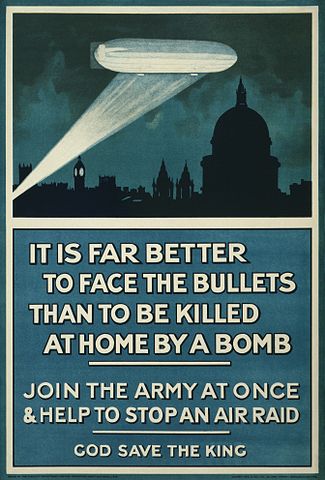Which Way the Trolley: America’s Hot Wars During the Cold War, Part 1
The War and civilian casualties
World War II was also a war in which both sides inflicted tremendous civilian casualties on their enemies without much thought or restraint. One prominent ethicist who studied the issue believes that the mass killing of civilians in WWII by the Allied air power was a “drift” into that policy, not something intended or carefully thought out.[9]
 By way of president, in World War I (1914-1918), the Germans had bombed London with Zeppelins and bomber aircraft, and that campaign included an incident when a hospital was hit causing many casualties. Further, the Germans had pounded Paris with a high tech, long range canon that also caused considerable civilian casualties, including many who died when a church roof was hit and collapsed. The Allied powers were not guiltless. The British navy imposed a blockade on Germany which caused great hardship and starvation to German civilians. British and French aircraft had bombed the industrial Ruhr with little effect but some civilian casualties. A British bomber force of large four engine bombers was at the point of beginning its bombings campaign on Germany as the war ended.
By way of president, in World War I (1914-1918), the Germans had bombed London with Zeppelins and bomber aircraft, and that campaign included an incident when a hospital was hit causing many casualties. Further, the Germans had pounded Paris with a high tech, long range canon that also caused considerable civilian casualties, including many who died when a church roof was hit and collapsed. The Allied powers were not guiltless. The British navy imposed a blockade on Germany which caused great hardship and starvation to German civilians. British and French aircraft had bombed the industrial Ruhr with little effect but some civilian casualties. A British bomber force of large four engine bombers was at the point of beginning its bombings campaign on Germany as the war ended.
World War II began (1939) with the Germans bombing Polish, Belgium and Dutch cities to force those governments into immediate surrender – it worked in the case of the Netherlands. The bombing of cities continued in the Nazi air “Blitz” over the United Kingdom.[10] This was pictured in the 1940 movie, Mrs. Miniver, in which a village on the outskirts of London received severe damage and civilians died. In the last scene, the Anglican priest gave a sermon amidst his damaged church and eloquently proclaimed:
The homes of many of us have been destroyed, and the lives of young and old have been taken… Children, old people, a young girl at the height of her loveliness? Why these? Are these our soldiers? Are these our fighters? Why should they be sacrificed?
I shall tell you why. Because this is not only a war of soldiers in uniform. It is the war of the people, of all the people. And it must be fought not only on the battlefield but in the cities and in the villages, in the factories and on the farms, in the home and in the heart of every man, woman and child who loves freedom… This is the People’s War. It is our war. We are the fighters. Fight it then. Fight it with all that is in us. And may God defend the right.[11]
The public was being educated to the fact that modern war would include many civilian casualties as a matter of course.
 In fact, British investigating teams examining the bomb damage in their cities learned that losing a home or family member was very demoralizing, and could paralyze and confuse the war industry work done by the survivors. When the British built up their own bombing campaign against Nazi Germany, they purposely bombed residential neighborhoods in an attempt to do similarly and break German morale.[12]
In fact, British investigating teams examining the bomb damage in their cities learned that losing a home or family member was very demoralizing, and could paralyze and confuse the war industry work done by the survivors. When the British built up their own bombing campaign against Nazi Germany, they purposely bombed residential neighborhoods in an attempt to do similarly and break German morale.[12]
The British came closer to winning the war this way than most people know. In 1943, the industrial and port city of Hamburg was attacked by both British and American bombers.[13] This caused a firestorm with hurricane force winds that spread and consumed the city. Perhaps 40,000 persons, almost all civilians, died in the attack. The Nazi leadership was thrown into temporary disarray and Hitler commented to his inner group that if other firestorms came to major German cities he would have to sue for peace. A firestorm of that scale was not caused again, though the British tried many times and suffered heavy air crew losses in the process.[14] Although Berlin never experienced a firestorm such as Hamburg, by the end of the war it was transformed into rubble by multiple British, American and Soviet bomber raids.
Category: Church History, Fall 2016


